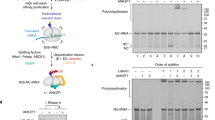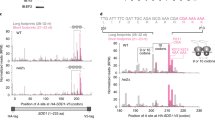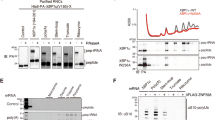Abstract
Stalled translation produces incomplete, ribosome-tethered polypeptides that the ribosome-associated quality control (RQC) pathway targets for degradation via the E3 ubiquitin ligase Ltn1. During this process, the protein Rqc2 and the large ribosomal subunit elongate stalled polypeptides with carboxy-terminal alanine and threonine residues (CAT tails). Failure to degrade CAT-tailed proteins disrupts global protein homeostasis, as CAT-tailed proteins can aggregate and sequester chaperones. Why cells employ such a potentially toxic process during RQC is unclear. Here, we developed quantitative techniques to assess how CAT tails affect stalled polypeptide degradation in Saccharomyces cerevisiae. We found that CAT tails enhance the efficiency of Ltn1 in targeting structured polypeptides, which are otherwise poor Ltn1 substrates. If Ltn1 fails to ubiquitylate those stalled polypeptides or becomes limiting, CAT tails act as degrons, marking proteins for proteasomal degradation off the ribosome. Thus, CAT tails functionalize the carboxy termini of stalled polypeptides to drive their degradation on and off the ribosome.
This is a preview of subscription content, access via your institution
Access options
Access Nature and 54 other Nature Portfolio journals
Get Nature+, our best-value online-access subscription
$29.99 / 30 days
cancel any time
Subscribe to this journal
Receive 12 print issues and online access
$189.00 per year
only $15.75 per issue
Buy this article
- Purchase on Springer Link
- Instant access to full article PDF
Prices may be subject to local taxes which are calculated during checkout





Similar content being viewed by others
Data availability
The datasets that inform the conclusions of this study are available from the corresponding author upon request.
References
Bengtson, M. H. & Joazeiro, C. A. P. Role of a ribosome-associated E3 ubiquitin ligase in protein quality control. Nature 467, 470–473 (2010).
Brandman, O. et al. A ribosome-bound quality control complex triggers degradation of nascent peptides and signals translation stress. Cell 151, 1042–1054 (2012).
Defenouillère, Q. et al. Cdc48-associated complex bound to 60S particles is required for the clearance of aberrant translation products. Proc. Natl Acad. Sci. USA 110, 5046–5051 (2013).
Tsuboi, T. et al. Dom34:hbs1 plays a general role in quality-control systems by dissociation of a stalled ribosome at the 3′ end of aberrant mRNA. Mol. Cell 46, 518–529 (2012).
Shao, S., von der Malsburg, K. & Hegde, R. S. Listerin-dependent nascent protein ubiquitination relies on ribosome subunit dissociation. Mol. Cell 50, 637–648 (2013).
Letzring, D. P., Dean, K. M. & Grayhack, E. J. Control of translation efficiency in yeast by codon–anticodon interactions. RNA https://doi.org/10.1261/rna.2411710 (2010).
Ito-Harashima, S., Kuroha, K., Tatematsu, T. & Inada, T. Translation of the poly(A) tail plays crucial roles in nonstop mRNA surveillance via translation repression and protein destabilization by proteasome in yeast. Genes Dev. 21, 519–524 (2007).
Simms, C. L., Yan, L. L. & Zaher, H. S. Ribosome collision is critical for quality control during no-go decay. Mol. Cell 68, 361–373.e5 (2017).
Juszkiewicz, S. et al. ZNF598 is a quality control sensor of collided ribosomes. Mol. Cell 72, 469–481.e7 (2018).
Ikeuchi, K. et al. Collided ribosomes form a unique structural interface to induce Hel2-driven quality control pathways. EMBO J. 38, e100276 (2019).
Sundaramoorthy, E. et al. ZNF598 and RACK1 regulate mammalian ribosome-associated quality control function by mediating regulatory 40S ribosomal ubiquitylation. Mol. Cell 65, 751–760.e4 (2017).
Juszkiewicz, S. & Hegde, R. S. Initiation of quality control during poly(A) translation requires site-specific ribosome ubiquitination. Mol. Cell 65, 743–750.e4 (2017).
Matsuo, Y. et al. Ubiquitination of stalled ribosome triggers ribosome-associated quality control. Nat. Commun. 8, 159 (2017).
Shoemaker, C. J., Eyler, D. E. & Green, R. Dom34:Hbs1 promotes subunit dissociation and peptidyl-tRNA drop-off to initiate no-go decay. Science 330, 369–372 (2010).
Pisareva, V. P., Skabkin, M. A., Hellen, C. U. T., Pestova, T. V. & Pisarev, A. V. Dissociation by Pelota, Hbs1 and ABCE1 of mammalian vacant 80S ribosomes and stalled elongation complexes. EMBO J. 30, 1804–1817 (2011).
Lyumkis, D. et al. Structural basis for translational surveillance by the large ribosomal subunit-associated protein quality control complex. Proc. Natl Acad. Sci. USA 111, 15981–15986 (2014).
Sitron, C. S., Park, J. H. & Brandman, O. Asc1, Hel2, and Slh1 couple translation arrest to nascent chain degradation. RNA 23, 798–810 (2017).
Shao, S., Brown, A., Santhanam, B. & Hegde, R. S. Structure and assembly pathway of the ribosome quality control complex. Mol. Cell 57, 433–444 (2015).
Shen, P. S. et al. Protein synthesis. Rqc2p and 60S ribosomal subunits mediate mRNA-independent elongation of nascent chains. Science 347, 75–78 (2015).
Osuna, B. A., Howard, C. J., Kc, S., Frost, A. & Weinberg, D. E. In vitro analysis of RQC activities provides insights into the mechanism and function of CAT tailing. eLife 6, e27949 (2017).
Choe, Y.-J. et al. Failure of RQC machinery causes protein aggregation and proteotoxic stress. Nature 531, 191–195 (2016).
Yonashiro, R. et al. The Rqc2/Tae2 subunit of the ribosome-associated quality control (RQC) complex marks ribosome-stalled nascent polypeptide chains for aggregation. eLife 5, e11794 (2016).
Defenouillère, Q. et al. Rqc1 and Ltn1 prevent CAT-tail induced protein aggregation by efficient recruitment of Cdc48 on stalled 60S subunits. J. Biol. Chem. 291, 12245–12253 (2016).
Chu, J. et al. A mouse forward genetics screen identifies LISTERIN as an E3 ubiquitin ligase involved in neurodegeneration. Proc. Natl Acad. Sci. USA 106, 2097–2103 (2009).
Kostova, K. K. et al. CAT-tailing as a fail-safe mechanism for efficient degradation of stalled nascent polypeptides. Science 357, 414–417 (2017).
Dimitrova, L. N., Kuroha, K., Tatematsu, T. & Inada, T. Nascent peptide-dependent translation arrest leads to Not4p-mediated protein degradation by the proteasome. J. Biol. Chem. 284, 10343–10352 (2009).
Donnelly, M. L. L. et al. Analysis of the aphthovirus 2A/2B polyprotein ‘cleavage’ mechanism indicates not a proteolytic reaction, but a novel translational effect: a putative ribosomal ‘skip’. J. Gen. Virol. 82, 1013–1025 (2001).
Szymczak, A. L. & Vignali, D. A. A. Development of 2A peptide-based strategies in the design of multicistronic vectors. Expert Opin. Biol. Ther. 5, 627–638 (2005).
Voss, N. R., Gerstein, M., Steitz, T. A. & Moore, P. B. The geometry of the ribosomal polypeptide exit tunnel. J. Mol. Biol. 360, 893–906 (2006).
Kelkar, D. A., Khushoo, A., Yang, Z. & Skach, W. R. Kinetic analysis of ribosome-bound fluorescent proteins reveals an early, stable, cotranslational folding intermediate. J. Biol. Chem. 287, 2568–2578 (2012).
Patterson, G. H., Knobel, S. M., Sharif, W. D., Kain, S. R. & Piston, D. W. Use of the green fluorescent protein and its mutants in quantitative fluorescence microscopy. Biophys. J. 73, 2782–2790 (1997).
Pédelacq, J.-D., Cabantous, S., Tran, T., Terwilliger, T. C. & Waldo, G. S. Engineering and characterization of a superfolder green fluorescent protein. Nat. Biotechnol. 24, 79–88 (2006).
Batey, S. & Clarke, J. Apparent cooperativity in the folding of multidomain proteins depends on the relative rates of folding of the constituent domains. Proc. Natl Acad. Sci. USA 103, 18113–18118 (2006).
Nilsson, O. B. et al. Cotranslational folding of spectrin domains via partially structured states. Nat. Struct. Mol. Biol. 24, 221–225 (2017).
Kamiyama, D. et al. Versatile protein tagging in cells with split fluorescent protein. Nat. Commun. 7, 11046 (2016).
Crosas, B. et al. Ubiquitin chains are remodeled at the proteasome by opposing ubiquitin ligase and deubiquitinating activities. Cell 127, 1401–1413 (2006).
Maurer, M. J. et al. Degradation signals for ubiquitin-proteasome dependent cytosolic protein quality control (CytoQC) in yeast. G3 6, 1853–1866 (2016).
Koegl, M. et al. A novel ubiquitination factor, E4, is involved in multiubiquitin chain assembly. Cell 96, 635–644 (1999).
Aviram, S. & Kornitzer, D. The ubiquitin ligase Hul5 promotes proteasomal processivity. Mol. Cell. Biol. 30, 985–994 (2010).
Fang, N. N., Ng, A. H. M., Measday, V. & Mayor, T. Hul5 HECT ubiquitin ligase plays a major role in the ubiquitylation and turnover of cytosolic misfolded proteins. Nat. Cell Biol. 13, 1344–1352 (2011).
Fang, N. N. & Mayor, T. Hul5 ubiquitin ligase: good riddance to bad proteins. Prion 6, 240–244 (2012).
Charneski, C. A. & Hurst, L. D. Positively charged residues are the major determinants of ribosomal velocity. PLoS Biol. 11, e1001508 (2013).
Requião, R. D., de Souza, H. J. A., Rossetto, S., Domitrovic, T. & Palhano, F. L. Increased ribosome density associated to positively charged residues is evident in ribosome profiling experiments performed in the absence of translation inhibitors. RNA Biol. 13, 561–568 (2016).
Weinberg, D. E. et al. Improved ribosome-footprint and mRNA measurements provide insights into dynamics and regulation of yeast translation. Cell Rep. 14, 1787–1799 (2016).
Koren, I. et al. The eukaryotic proteome is shaped by E3 ubiquitin ligases targeting C-terminal degrons. Cell 173, 1622–1635.e14 (2018).
Doamekpor, S. K. et al. Structure and function of the yeast listerin (Ltn1) conserved N-terminal domain in binding to stalled 60S ribosomal subunits. Proc. Natl Acad. Sci. USA 113, E4151–E4160 (2016).
Meaux, S. & Van Hoof, A. Yeast transcripts cleaved by an internal ribozyme provide new insight into the role of the cap and poly(A) tail in translation and mRNA decay. RNA 12, 1323–1337 (2006).
Ozkan, E., Yu, H. & Deisenhofer, J. Mechanistic insight into the allosteric activation of a ubiquitin-conjugating enzyme by RING-type ubiquitin ligases. Proc. Natl Acad. Sci. USA 102, 18890–18895 (2005).
Plechanovová, A., Jaffray, E. G., Tatham, M. H., Naismith, J. H. & Hay, R. T. Structure of a RING E3 ligase and ubiquitin-loaded E2 primed for catalysis. Nature 489, 115–120 (2012).
Pruneda, J. N. et al. Structure of an E3: E2 Ub complex reveals an allosteric mechanism shared among RING/U-box ligases. Mol. Cell 47, 933–942 (2012).
Deshaies, R. J. & Joazeiro, C. A. RING domain E3 ubiquitin ligases. Annu. Rev. Biochem. 78, 399–434 (2009).
Cabrita, L. D., Hsu, S.-T. D., Launay, H., Dobson, C. M. & Christodoulou, J. Probing ribosome-nascent chain complexes produced in vivo by NMR spectroscopy. Proc. Natl Acad. Sci. USA 106, 22239–22244 (2009).
Eichmann, C., Preissler, S., Riek, R. & Deuerling, E. Cotranslational structure acquisition of nascent polypeptides monitored by NMR spectroscopy. Proc. Natl Acad. Sci. USA 107, 9111–9116 (2010).
Gibson, D. G. et al. Enzymatic assembly of DNA molecules up to several hundred kilobases. Nat. Methods 6, 343–345 (2009).
Wallace, E. W. J. et al. Reversible, specific, active aggregates of endogenous proteins assemble upon heatstress. Cell 162, 1286–1298 (2015).
Acknowledgements
We thank S. Marqusee, J. Frydman, R. Hegde and B. Lu for helpful discussions. We thank L. Steinman, R. Kopito, E.P. Geiduschek and members of the Brandman and Kopito Labs for comments on the manuscript. We acknowledge J. Work (Stanford University, Stanford, CA, USA) for his gift of the 10–31 degron and control plasmids. J. Schulze (University of California at Davis, Davis, CA, USA) performed the amino acid analysis at the UC Davis Genome Center Molecular Structure Facility. Stanford University (O.B.), the US National Institutes of Health (grant No. R01GM115968 to O.B.), and the National Institute of General Medical Sciences of the US National Institutes of Health (grant No. T32GM007276 to C.S.S.) supported this work.
Author information
Authors and Affiliations
Contributions
O.B. and C.S.S. conceived of the study and designed the experiments. C.S.S. performed the experiments. O.B. and C.S.S. analyzed and interpreted the data. O.B. and C.S.S. wrote the manuscript. O.B. supervised the study.
Corresponding author
Ethics declarations
Competing interests
The authors declare no competing interests.
Additional information
Publisher’s note: Springer Nature remains neutral with regard to jurisdictional claims in published maps and institutional affiliations.
Integrated supplementary information
Supplementary Fig. 1 Controlling for substrate expression to enable more faithful measurement of RQC substrate degradation.
a, Mean RFP measurements from an internal expression control for a model RQC substrate. GST (glutathione S-transferase) was used in place of GFP to eliminate GFP bleed-through into the RFP channel when measuring the levels of the RFP expression control in this experiment. b, Comparison of mean expression-controlled (GFP:RFP) and bulk (GFP) measurements of a non-stalling two-color construct. c, Normalized stability measurements for two model RQC substrates (schematic above) from Fig. 1e with additional ltn1∆ background controls displayed (n = 5 independent cultures). Data are normalized as in Fig. 1. d, Quantification of a stalling reporter similar to that developed by the Hegde and Bennett laboratories (schematic above)9,11. The 12xArg stalling sequence matches that from other model RQC substrates used. hel2∆ and slh1∆ strains have previously been shown to be deficient in stalling11,12,13,17. e, Non-normalized stability measurements from a model RQC substrate, RQCsubLONG (schematic above), expressed from the moderate MET17 promoter and the strong TDH3 promoter. f, Additional ltn1∆ background controls displayed for stability data in Fig. 1f. For all bar plots, error bars indicate s.e.m. from n = 3 independent cultures unless otherwise indicated.
Supplementary Fig. 2 Additional ltn1∆ background controls for substrates in Fig. 2.
a–c, Normalized stability measurements of two model RQC substrates (schematic above) from Fig. 2c–e with additional ltn1∆ background controls displayed. Cartoons of structural features of the substrates shown emerging from the ribosome exit tunnel below. For all bar plots, data is normalized as in Fig. 1f and error bars indicate s.e.m. from n = 3 independent cultures.
Supplementary Fig. 3 hul5∆ stabilizes an RQC substrate in the ltn1∆ background comparably to loss of CATylation.
a, Mean stability of RQCsubLONG in the ltn1∆ background with or without deletion of the vacuolar proteinase maturation factor PEP4. Error bars are s.e.m. from n = 3 independent cultures. The results of a one-way, one-tailed ANOVA test with 4 degrees of freedom are indicated above bars. b, IB of cells expressing RQCsubLONG (schematic above) with and without TEV protease co-expression. c, Normalized stability of RQCsubLONG in the ltn1∆ background with additional deletions of ubiquitin proteasome system factors. Data are presented as mean, normalized against ltn1∆ (normalized to 0) and rqc2-d98a ltn1∆ (normalized to 1). d, RQCsubLONG stability after cycloheximide (200 μg/ml) pulse in the ltn1∆ background with or without perturbations to CATylation (rqc2-d98a) or HUL5. Data are normalized to the value measured just before cycloheximide addition and error bars indicate s.e.m. from n = 3 independent cultures. e, Amino acid analysis of RQCsubLONG IPed from indicated strains competent in CATylation (ltn1∆), with impaired CATylation (rqc2-d98a ltn1∆), or with impaired HUL5 (hul5∆ ltn1∆). f, Mean stability measurements of a two color construct with or without a non-stalling C-terminal degron, called “10–31.” Results from one-way, one-tailed ANOVA tests with 4 degrees of freedom indicated above bars. Error bars indicate s.e.m. from n = 3 independent cultures.
Supplementary Fig. 4 Effects of Ltn1-independent degradation blockade on substrate size and solubility.
a, IB replicates of ltn1∆ whole cell extracts containing RQCsubLONG with or without HUL5 deletion. b, IB of RQCsubLONG from whole cell extracts of ltn1∆ with indicated RQC2 alleles that produce CAT tails of varying size. c, Stability measurements from ltn1∆ cells carrying different RQC2 alleles, expressing RQCsubLONG. Data are normalized as in Supplementary Fig. 3b and error bars indicate s.e.m. from n = 3 independent cultures. d, IB of fractions from supernatant-pellet fraction of ltn1∆ lysates expressing RQCsubLONG.
Supplementary Fig. 5 Additional data for decomposition of CAT tail function.
a, Stability measurements of RQCsubLONG and RQCsubLONG with the C-terminal GFP lysine residue mutated (RQCsubLONG-KlastR, as in Fig. 1f) with additional perturbations of HUL5 deletion, TEV co-expression, and RQC2 mutation. Data are presented as mean, normalized against the no perturbation condition (normalized to 0) and rqc2-d98a (normalized to 1). Error bars indicate s.e.m. from n = 3 independent cultures and results of indicated one-way, one-tailed ANOVA tests appear above the bars (4 d.o.f.). Because the value in the hul5∆ + in vivo TEV condition was slightly greater with RQC2-WT than rqc2-d98a, we considered all CAT tail-mediated degradation to be abolished in the former condition (RQC2-WT hul5∆ + in vivo TEV).
Supplementary Fig. 6 Example workflow for flow cytometry analysis.
a, Example log-scale scatter plot of flow cytometry results from single cultures of indicated strains expressing RQCsubLONG (for schematic see Fig. 1e) or RFP-(T2A)2-GST-stall (an RFP-only control to assess RFP bleed-through into GFP channel, for schematic see Supplementary Fig. 1a). Each set of points represents a single independent culture that contributed towards the measurements in Supplementary Fig. 1c. GFP fluorescence was measured through the FL1-A channel and RFP was measured through the FL4-A channel. Cells were gated based on RFP fluorescence to determine cells for which the GFP:RFP ratio (slope) was linear. The upper and lower bounds of this gate are indicated by the dotted vertical lines. b, Mean GFP:RFP from cultures in a. While a is on a log scale, b is on a linear scale. c, GFP:RFP from cultures expressing RQCsubLONG in b after subtraction of RFP-only background from RFP-(T2A)2-GST-stall. d, GFP:RFP from c normalized to rqc2-d98a ltn1∆. Plots derived in a similar fashion to c and d appear throughout the figures.
Supplementary information
Supplementary Information
Supplementary Figs. 1–6, Supplementary Tables 1–2
Rights and permissions
About this article
Cite this article
Sitron, C.S., Brandman, O. CAT tails drive degradation of stalled polypeptides on and off the ribosome. Nat Struct Mol Biol 26, 450–459 (2019). https://doi.org/10.1038/s41594-019-0230-1
Received:
Accepted:
Published:
Issue Date:
DOI: https://doi.org/10.1038/s41594-019-0230-1
This article is cited by
-
Structural basis for clearing of ribosome collisions by the RQT complex
Nature Communications (2023)
-
Protein quality control: from molecular mechanisms to therapeutic intervention—EMBO workshop, May 21–26 2023, Srebreno, Croatia
Cell Stress and Chaperones (2023)
-
Ageing exacerbates ribosome pausing to disrupt cotranslational proteostasis
Nature (2022)
-
Inefficient quality control of ribosome stalling during APP synthesis generates CAT-tailed species that precipitate hallmarks of Alzheimer’s disease
Acta Neuropathologica Communications (2021)
-
Quality control of the mitochondrial proteome
Nature Reviews Molecular Cell Biology (2021)



